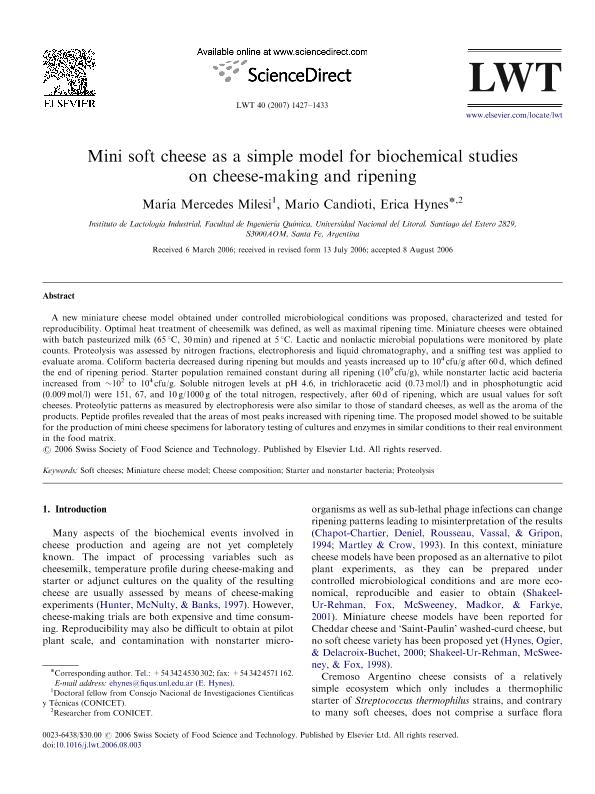Mostrar el registro sencillo del ítem
dc.contributor.author
Milesi, Maria Mercedes

dc.contributor.author
Candioti, Mario César

dc.contributor.author
Hynes, Erica Rut

dc.date.available
2020-09-15T14:41:57Z
dc.date.issued
2007-08
dc.identifier.citation
Milesi, Maria Mercedes; Candioti, Mario César; Hynes, Erica Rut; Mini soft cheese as a simple model for biochemical studies on cheese-making and ripening; Elsevier Science; LWT - Food Science and Technology; 40; 8; 8-2007; 1427-1433
dc.identifier.issn
0023-6438
dc.identifier.uri
http://hdl.handle.net/11336/113998
dc.description.abstract
A new miniature cheese model obtained under controlled microbiological conditions was proposed, characterized and tested for reproducibility. Optimal heat treatment of cheesemilk was defined, as well as maximal ripening time. Miniature cheeses were obtained with batch pasteurized milk (65 °C, 30 min) and ripened at 5 °C. Lactic and nonlactic microbial populations were monitored by plate counts. Proteolysis was assessed by nitrogen fractions, electrophoresis and liquid chromatography, and a sniffing test was applied to evaluate aroma. Coliform bacteria decreased during ripening but moulds and yeasts increased up to 104 cfu/g after 60 d, which defined the end of ripening period. Starter population remained constant during all ripening (109 cfu/g), while nonstarter lactic acid bacteria increased from ~102 to 104 cfu/g. Soluble nitrogen levels at pH 4.6, in trichloracetic acid (0.73 mol/l) and in phosphotungtic acid (0.009 mol/l) were 151, 67, and 10 g/1000 g of the total nitrogen, respectively, after 60 d of ripening, which are usual values for soft cheeses. Proteolytic patterns as measured by electrophoresis were also similar to those of standard cheeses, as well as the aroma of the products. Peptide profiles revealed that the areas of most peaks increased with ripening time. The proposed model showed to be suitable for the production of mini cheese specimens for laboratory testing of cultures and enzymes in similar conditions to their real environment in the food matrix.
dc.format
application/pdf
dc.language.iso
eng
dc.publisher
Elsevier Science

dc.rights
info:eu-repo/semantics/openAccess
dc.rights.uri
https://creativecommons.org/licenses/by-nc-nd/2.5/ar/
dc.subject
CHEESE COMPOSITION
dc.subject
MINIATURE CHEESE MODEL
dc.subject
PROTEOLYSIS
dc.subject
SOFT CHEESES
dc.subject
STARTER AND NONSTARTER BACTERIA
dc.subject.classification
Otras Ciencias Biológicas

dc.subject.classification
Ciencias Biológicas

dc.subject.classification
CIENCIAS NATURALES Y EXACTAS

dc.title
Mini soft cheese as a simple model for biochemical studies on cheese-making and ripening
dc.type
info:eu-repo/semantics/article
dc.type
info:ar-repo/semantics/artículo
dc.type
info:eu-repo/semantics/publishedVersion
dc.date.updated
2020-09-03T19:24:37Z
dc.journal.volume
40
dc.journal.number
8
dc.journal.pagination
1427-1433
dc.journal.pais
Países Bajos

dc.journal.ciudad
Amsterdam
dc.description.fil
Fil: Milesi, Maria Mercedes. Consejo Nacional de Investigaciones Científicas y Técnicas. Centro Científico Tecnológico Conicet - Santa Fe. Instituto de Salud y Ambiente del Litoral. Universidad Nacional del Litoral. Instituto de Salud y Ambiente del Litoral; Argentina
dc.description.fil
Fil: Candioti, Mario César. Universidad Nacional del Litoral; Argentina
dc.description.fil
Fil: Hynes, Erica Rut. Consejo Nacional de Investigaciones Científicas y Técnicas. Centro Científico Tecnológico Conicet - Santa Fe. Instituto de Lactología Industrial. Universidad Nacional del Litoral. Facultad de Ingeniería Química. Instituto de Lactología Industrial; Argentina
dc.journal.title
LWT - Food Science and Technology

dc.relation.alternativeid
info:eu-repo/semantics/altIdentifier/doi/http://dx.doi.org/10.1016/j.lwt.2006.08.003
Archivos asociados
